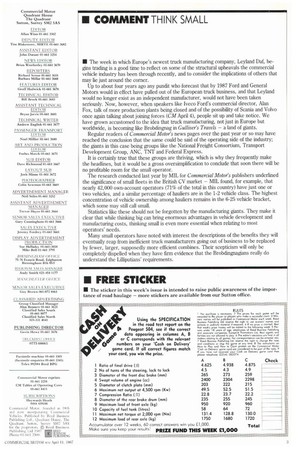• COMMENT THINK SMALL
Page 5

If you've noticed an error in this article please click here to report it so we can fix it.
• The week in which Europe's newest truck manufacturing company, Leyland Daf, begins trading is a good time to reflect on some of the structural upheavals the commercial vehicle industry has been through recently, and to consider the implications of others that may lie just around the corner.
Up to about four years ago any pundit who forecast that by 1987 Ford and General Motors would in effect have pulled out of the European truck business, and that Leyland would no longer exist as an independent manufacturer, would not have been taken seriously. Now, however, when speakers like Iveco Ford's commercial director, Alan Fox, talk of more production plants being closed and of the possibility of Scalia and Volvo once again talking about joining forces (CM April 4), people sit up and take notice. We have grown accustomed to the idea that truck manufacturing, not just in Europe but worldwide, is becoming like Brobdingnag in Gulliver's Travels — a land of giants.
Regular readers of Commercial Motor's news pages over the past year or so may have reached the conclusion that the same could be said of the operating side of the industry; the giants in this case being groups like the National Freight Consortium, Transport Development Group, ANC, TNT and Federal Express.
It is certainly true that these groups are thriving, which is why they frequently make the headlines, but it would be a gross oversimplification to conclude that soon there will be no profitable room for the small operator.
The research conducted last year by MIL for Commercial Motor's publishers underlined the significance of small fleets in the British CV market — MIL found, for example, that nearly 42,000 own-account operators (71% of the total in this country) have just one or two vehicles, and a similar percentage of hauliers are in the 1-2 vehicle class. The highest concentration of vehicle ownership among hauliers remains in the 6-25 vehicle bracket, which some may still call small.
Statistics like these should not be forgotten by the manufacturing giants. They make it clear that while thinking big can bring enormous advantages in vehicle development and manufacturing costs, thinking small is even more essential when relating to most operators' needs.
Many small operators have noted with interest the descriptions of the benefits they will eventually reap from inefficient truck manufacturers going out of business to be replaced by fewer, larger, supposedly more efficient combines. Their scepticism will only be completely dispelled when they have firm evidence that the Brobdingnagians really do understand the Lilliputians' requirements.




























































































